Multi-purpose Zoom Microscopes MULTIZOOM AZ100
Enjoy the combined advantages of a stereoscopic microscope with a wide field of view and a long working distance, and a compound microscope boasting high-resolution images–the multi-purpose zoom microscope MULTIZOOM AZ100 is Nikon's latest groundbreaking microscope solution.

- The mono-zoom optical system enables on-axis observation and documentation.
- The large magnification range is from 5x to 500x.*
- High-resolution, high-contrast images can be viewed in the macro region.
- Various illumination techniques are possible, including DIC observation.
- *500x includes 1.25x device magnification of coaxial illuminator.
Macro observation by on-axis viewing
True on-axis observation and image capture are possible in the macro region due to the AZ100's elimination of the traditional stereoscope's angular view of the specimen.
Comparison of macro image

On-axis viewing with AZ100
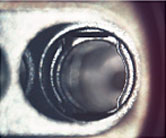
Angular viewing with a stereoscopic microscope
Mono zoom mechanism

Stereoscopic microscopes always capture images in a diagonal direction due to the structure of the device. The AZ100, however, captures high-resolution, high-contrast images with on-axis viewing.
A wide range of magnifications
By combining built-in 8x zoom optics, which provide from 1x to 8x magnification, with a three-position objective nosepiece, the AZ100 enables observation at the highest magnification ratio of any such device in the world. The objective lens lineup consists of 0.5x, 1x, 2x, 4x, and 5x lenses. When combined with AZ-W 10x eyepiece lenses, the AZ100 covers everything from low, through medium to high magnification. In the range of 5x to 500x (the latter includes the 1.25x device magnification of the coaxial illuminator). The zoom knob incorporates an engageable click-stop mechanism for measuring and reproducing magnification settings.

Zoom click mechanism on knob

Triple nosepiece
Comes standard with an aperture stop
The AZ100 ships complete with an aperture stop that is effective not only for visual observation, but also for the capture of digital images. This aperture stop allows you to freely change contrast and field depth based on your specimen requirements.

Aperture stop
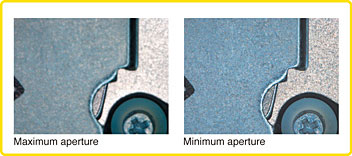
Comparative example
Superior flexibility
Tilting eyepiece tubes
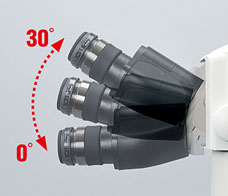
The AZ100 comes standard with eyepiece tubes that tilt from 0° to 30°. This feature enables the optimal eye level for the observer's height and posture as well as the sample height. Two different beam-split ratios for the binocular and photo port can be selected: 100:0/0:100, which is suitable for photo documentation; or 100:0/20:80, which enables visual observation while displaying an image on a monitor.
Stands
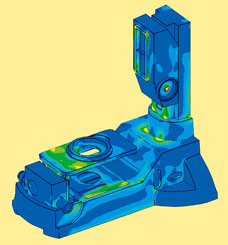
Nikon has developed two new extremely stable dedicated stands: a reflected-only and a dual-purpose reflected/transmitted illumination stand. Even during observation at high magnifications, these stands enable stable, blur-free observation.
Double-coarse/fine focusing system

- *Differs depending on the objectives and stand combination.
Focusing can be done using either the AZ stand or stage controls. Since the stand section offers an 85mm stroke and the stage section a 10mm stroke, even tall samples can easily be observed. Focusing the stage can be performed easily with up-front table-level controls, without having to put your hands above the sample.
Dedicated stages

The product lineup consists of a reflected-only and a dual-purpose reflected/transmitted illumination stage. The three-plate structure of the stage enables stable operation even for observation at high magnification. They provide superior durability even when supporting heavy industrial samples.
Various microscopy methods
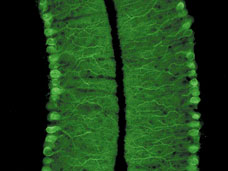
Epi-fluorescence

Diascopic DIC

Diascopic simple polarizing
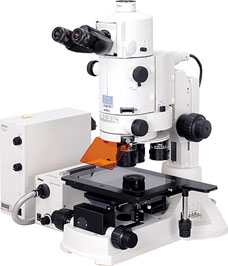
Configuation with epi-fluorescence and diascopic DIC attachments
In addition to brightfield observation, a wide range of observation methods is possible, including epi-fluorescence, Nomarski DIC, simple polarizing and oblique illumination. AZ100 enables simultaneous mounting of epi-fluorescence and diascopic DIC attachments, allowing effortless switching between observation modes.
